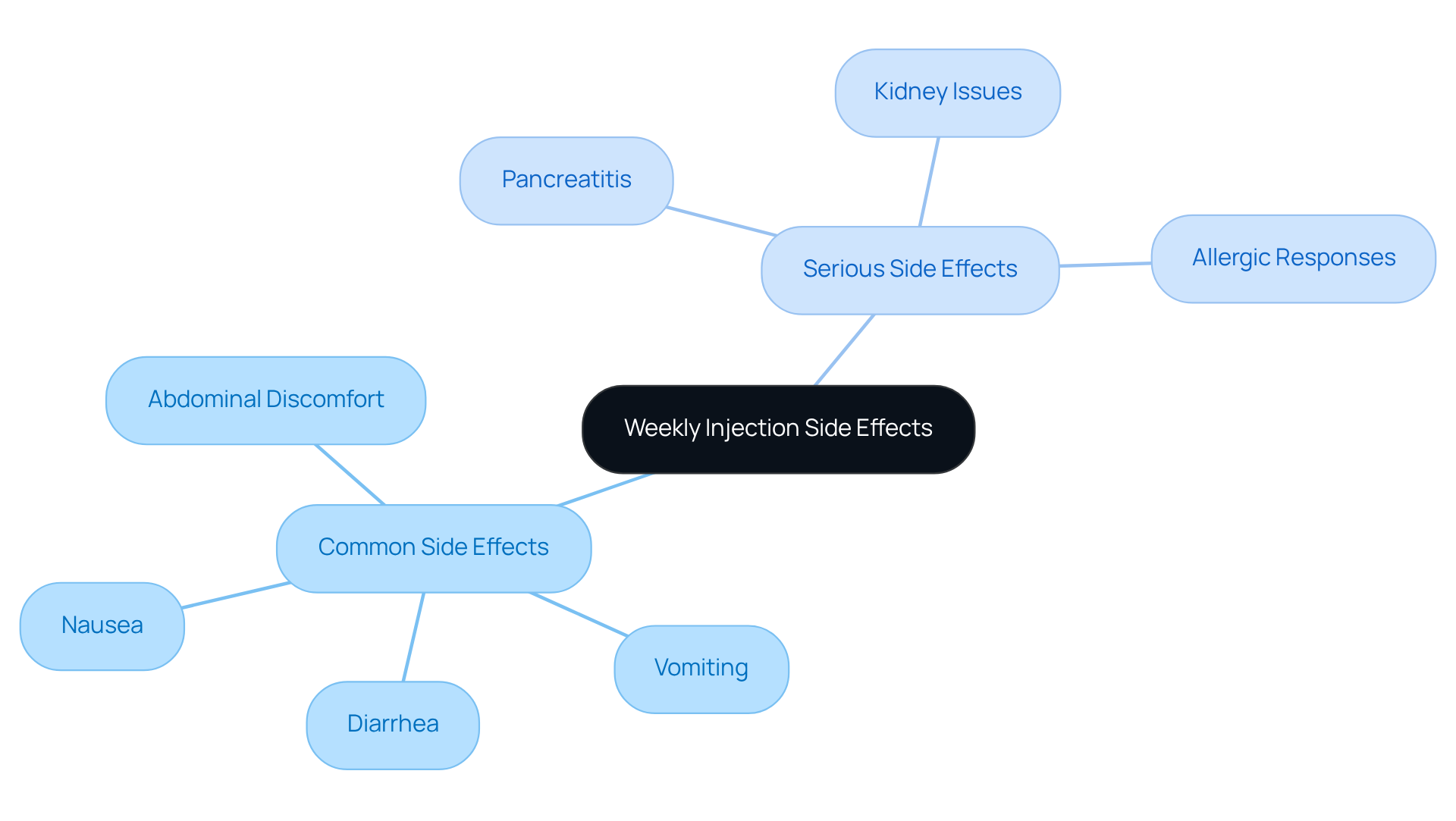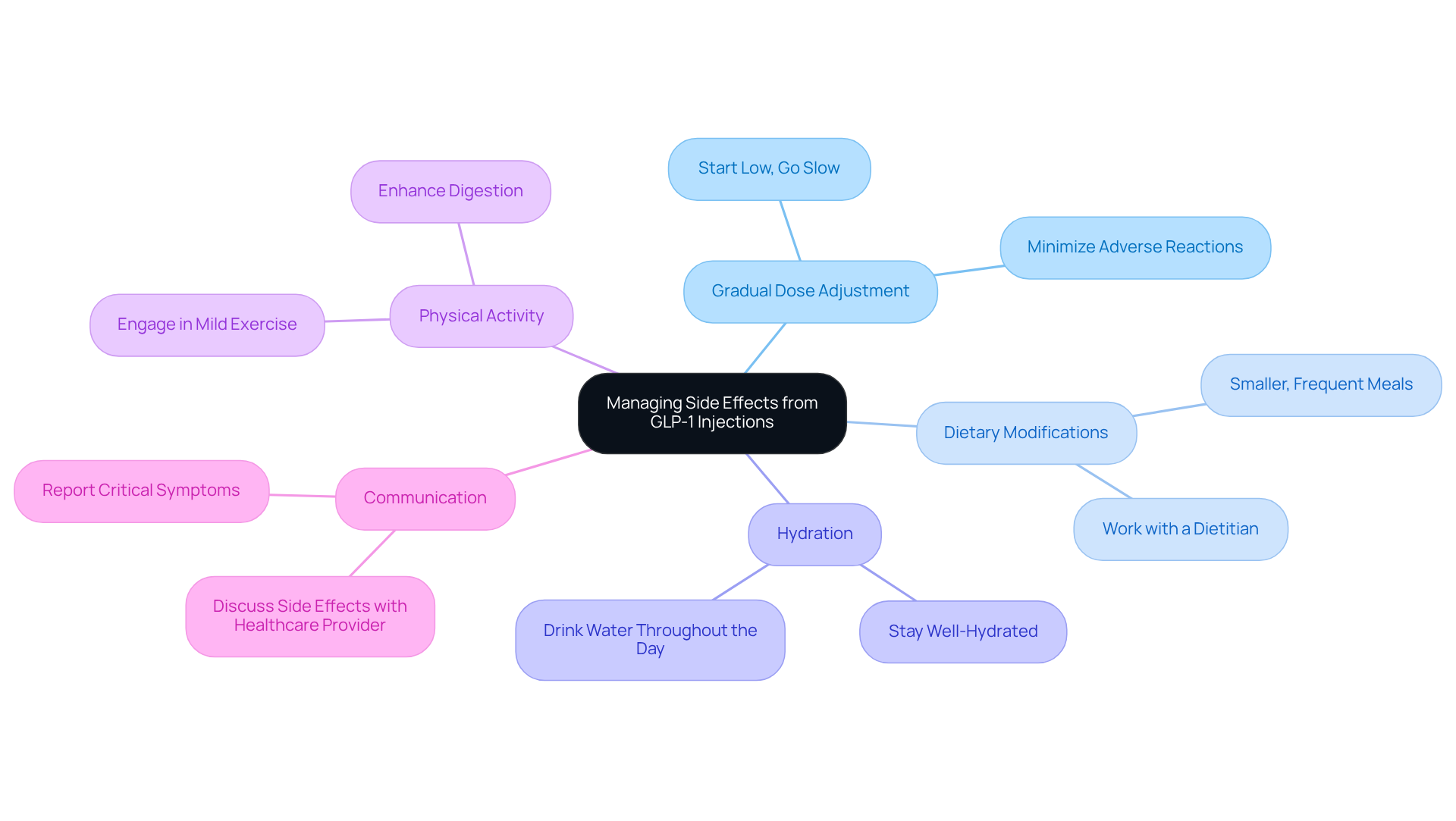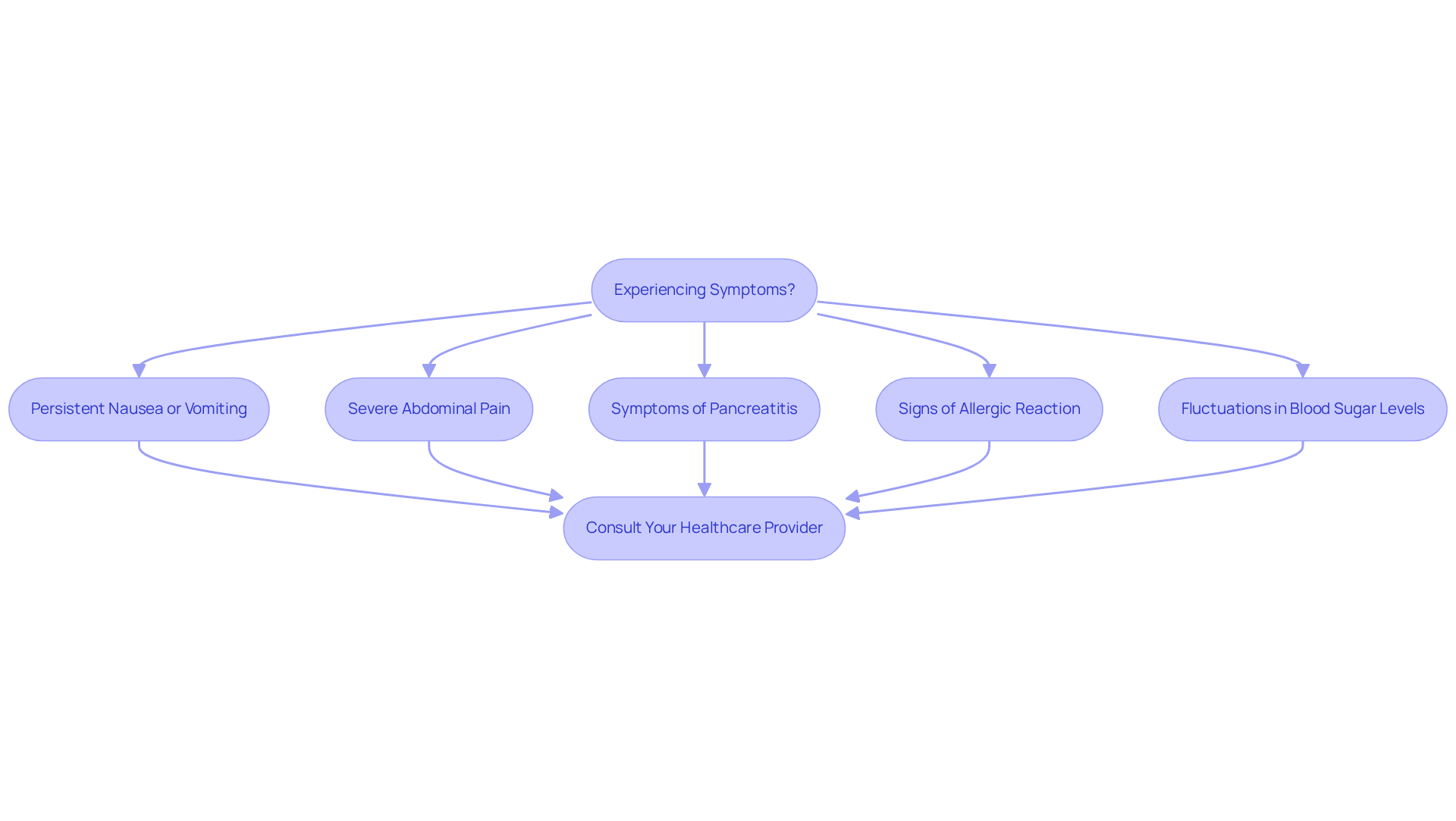Overview
This article compassionately addresses the management of side effects associated with once-a-week injections for Type 2 diabetes, particularly focusing on GLP-1 receptor agonists. It's understandable to feel concerned about common side effects like nausea and abdominal discomfort. But rest assured, there are effective strategies to help you manage these challenges.
- Gradual dose adjustments
- Dietary modifications
- Open communication with your healthcare provider
can make a significant difference in your comfort and well-being.
Navigating your treatment journey can feel overwhelming, but you are not alone in this. Many patients have found that sharing their experiences and seeking support from others can be incredibly beneficial. Remember, we are here to support you every step of the way as you explore the best options for your health. By taking proactive steps and reaching out for help, you can approach your treatment with confidence and peace of mind.
Introduction
Navigating the complexities of managing type 2 diabetes can feel overwhelming, especially with the introduction of innovative treatments like GLP-1 receptor agonists. These medications not only help regulate blood sugar levels but also provide additional benefits, such as weight loss and reduced cardiovascular risks. It’s completely understandable to have concerns about potential side effects, including nausea and abdominal discomfort. Recognizing these challenges is crucial for those embarking on this treatment journey.
How can patients effectively manage these side effects while reaping the full benefits of their diabetes medications? You're not alone in this journey, and we are here to support you every step of the way. Together, we can explore strategies to help you feel more at ease and empowered in your diabetes management.
Explore GLP-1 Receptor Agonists: Mechanism and Benefits
Receptor agonists for glucagon-like peptide-1 represent a remarkable advancement in diabetes care, mimicking the essential functions of this hormone for glucose metabolism. These innovative agents can significantly lower blood sugar levels by enhancing insulin secretion in response to meals, suppressing glucagon release, and slowing gastric emptying. It's encouraging to note that recent studies show patients using receptor agonists can experience substantial weight loss, with some achieving decreases of 10 to 14 pounds, alongside improvements in glycemic control, often reflected in A1C reductions of 2% to 3%.
Moreover, these medications are linked to a reduced risk of cardiovascular events, making them an important part of diabetes management. For instance, a significant observational study indicated that women on receptor agonists had an 8% lower risk of death from any cause compared to those on alternative therapies, and a 20% lower risk compared to those treated with DDP-4 inhibitors. Additionally, semaglutide 0.4 mg has shown a remarkable 59% resolution of nonalcoholic steatohepatitis (NASH), compared to just 17% in the placebo group, highlighting the broader benefits of these treatments.
Understanding how receptor agonists work can empower you to take an active role in your treatment journey. It's crucial to follow prescribed routines for optimal health outcomes. However, it's also important to be aware of potential side effects, such as nausea and abdominal discomfort, that may arise from a once a week injection for type 2 diabetes side effects, to manage your expectations effectively. As Dr. Robin Zon emphasizes, these medications may also play a role in reducing cancer risk, which is an important consideration for your long-term health. Remember, you are not alone in this journey, and we are here to support you every step of the way.

Identify Common and Serious Side Effects of Weekly Injections
It's common to experience reactions, such as nausea, vomiting, diarrhea, and abdominal discomfort, when starting a once a week injection for type 2 diabetes side effects like GLP-1 receptor agonists. These symptoms often lessen over time as your body adjusts to the medication, which can be reassuring. However, it's important to be aware that more severe reactions, including those related to the once a week injection for type 2 diabetes side effects, can occur, though they are less frequent. These may include pancreatitis, kidney issues, and allergic responses.
You might find it helpful to stay alert to any unusual symptoms. While some reactions to the once a week injection for type 2 diabetes side effects may be mild and temporary, others could require prompt medical attention. Remember, you're not alone in this journey. Keeping a symptom journal can be a valuable tool for monitoring your reactions and fostering meaningful conversations with your healthcare team. Sharing your experiences can lead to support and understanding, helping you feel more connected during this time.

Implement Strategies to Manage Side Effects Effectively
Managing side effects from GLP-1 injections can feel overwhelming, but there are several compassionate strategies that can help you navigate this journey:
-
Gradual Dose Adjustment: Starting with a lower dose and gradually increasing it allows your body to adapt more comfortably to the medication. This approach minimizes adverse reactions, which is crucial since research shows that GLP-1 therapies can lead to average weight losses of 5-18%. Taking the time to manage these reactions carefully is essential for effective treatment.
-
Dietary Modifications: Eating smaller, more frequent meals can significantly ease gastrointestinal symptoms like nausea and vomiting. For instance, Lynn-Pullman, a patient who faced these challenges, found that working with a dietitian helped her manage her food intake and symptoms effectively. This strategy not only reduces discomfort but also helps maintain stable blood sugar levels.
-
Hydration: Staying well-hydrated is vital for alleviating nausea and supporting your overall health. Drinking water throughout the day can help you manage adverse reactions more effectively. As Lynn-Pullman shared, hydration is key to feeling better while on GLP-1 medications.
-
Physical Activity: Engaging in mild exercise, such as walking or stretching, can enhance digestion and improve your overall well-being. Regular physical activity is beneficial for managing diabetes and can also help relieve some discomfort related to medication.
-
Communication: It's important to regularly discuss any side effects with your healthcare provider. Open communication can lead to necessary adjustments in your treatment or additional support tailored to your needs. Be mindful of critical symptoms that require immediate medical attention, such as severe vomiting, diarrhea, or abdominal pain, to ensure your safety while using GLP-1 injections.
These strategies can significantly improve your experience with the once a week injection for type 2 diabetes side effects, promoting better diabetes management and enhancing your quality of life. Remember, you're not alone in this journey, and we are here to support you every step of the way.

Monitor Your Health: When to Consult Your Healthcare Provider
Monitoring your well-being is essential for effective diabetes management and treatment. In 2021, diabetes was the eighth leading cause of death in the United States, a stark reminder of the importance of staying vigilant in managing this condition. If you experience any of the following symptoms, please consult your healthcare provider:
- Persistent nausea or vomiting that hinders your ability to eat or drink.
- Severe abdominal pain that does not improve over time.
- Symptoms indicative of pancreatitis, such as intense pain in the upper abdomen that may radiate to your back.
- Signs of an allergic reaction, including rash, itching, or difficulty breathing.
- Significant fluctuations in blood sugar levels that are challenging to control.
Regular consultations with your healthcare provider are crucial for addressing any emerging issues promptly. As Dr. Phil McGraw, who has lived with Type 2 Diabetes for over 25 years, emphasizes, proactive management is key to sustaining your well-being. This approach can lead to improved wellness outcomes and a better quality of life for those managing diabetes.
Moreover, the economic burden of diabetes management is significant, with direct costs rising from $227 billion in 2012 to $307 billion in 2022. This underscores the necessity of regular health monitoring and consultations. Remember, you're not alone in this journey; we are here to support you every step of the way.

Conclusion
The integration of GLP-1 receptor agonists into diabetes management is a significant step forward, offering patients not only improved glycemic control but also the potential for weight loss and a reduced risk of cardiovascular events. It's important for you to understand how these medications function, as this knowledge empowers you to engage actively in your treatment journey. Remember to stay mindful of the possible side effects that may accompany a once-a-week injection.
Throughout our discussion, we highlighted key insights, including:
- How GLP-1 receptor agonists lower blood sugar levels
- The common and serious side effects associated with their use
- Effective strategies for managing those side effects
Consider gradual dose adjustments, dietary modifications, and the importance of hydration and physical activity. These approaches can greatly enhance your experience with these medications. Additionally, maintaining open communication with your healthcare provider is crucial for timely intervention and support.
Ultimately, managing type 2 diabetes through GLP-1 receptor agonists is not just about medication; it’s about adopting a holistic approach to your health. By staying informed, monitoring your health closely, and being proactive in seeking assistance when needed, you can navigate your diabetes management journey more effectively. Embracing these strategies not only aids in managing side effects but also fosters a sense of empowerment and connection. Remember, you are not alone in this endeavor; we are here to support you every step of the way.
Frequently Asked Questions
What are GLP-1 receptor agonists and how do they work?
GLP-1 receptor agonists are medications that mimic the functions of the glucagon-like peptide-1 hormone, enhancing insulin secretion in response to meals, suppressing glucagon release, and slowing gastric emptying to lower blood sugar levels.
What benefits do GLP-1 receptor agonists provide for diabetes management?
These agents can lead to substantial weight loss (10 to 14 pounds), improve glycemic control (A1C reductions of 2% to 3%), and are associated with a reduced risk of cardiovascular events.
How do GLP-1 receptor agonists compare to other diabetes therapies in terms of mortality risk?
Studies indicate that women on GLP-1 receptor agonists have an 8% lower risk of death from any cause compared to those on alternative therapies, and a 20% lower risk compared to those treated with DDP-4 inhibitors.
What additional health benefits have been observed with GLP-1 receptor agonists?
Semaglutide 0.4 mg, a GLP-1 receptor agonist, has shown a 59% resolution of nonalcoholic steatohepatitis (NASH) compared to 17% in the placebo group, indicating broader health benefits beyond diabetes management.
What potential side effects should patients be aware of when using GLP-1 receptor agonists?
Potential side effects include nausea and abdominal discomfort, which may occur from the once-a-week injection for type 2 diabetes.
Can GLP-1 receptor agonists play a role in cancer risk reduction?
Yes, these medications may also help in reducing cancer risk, which is an important consideration for long-term health.
How can patients best manage their treatment with GLP-1 receptor agonists?
It is crucial to follow prescribed routines for optimal health outcomes and to be aware of potential side effects to manage expectations effectively.



